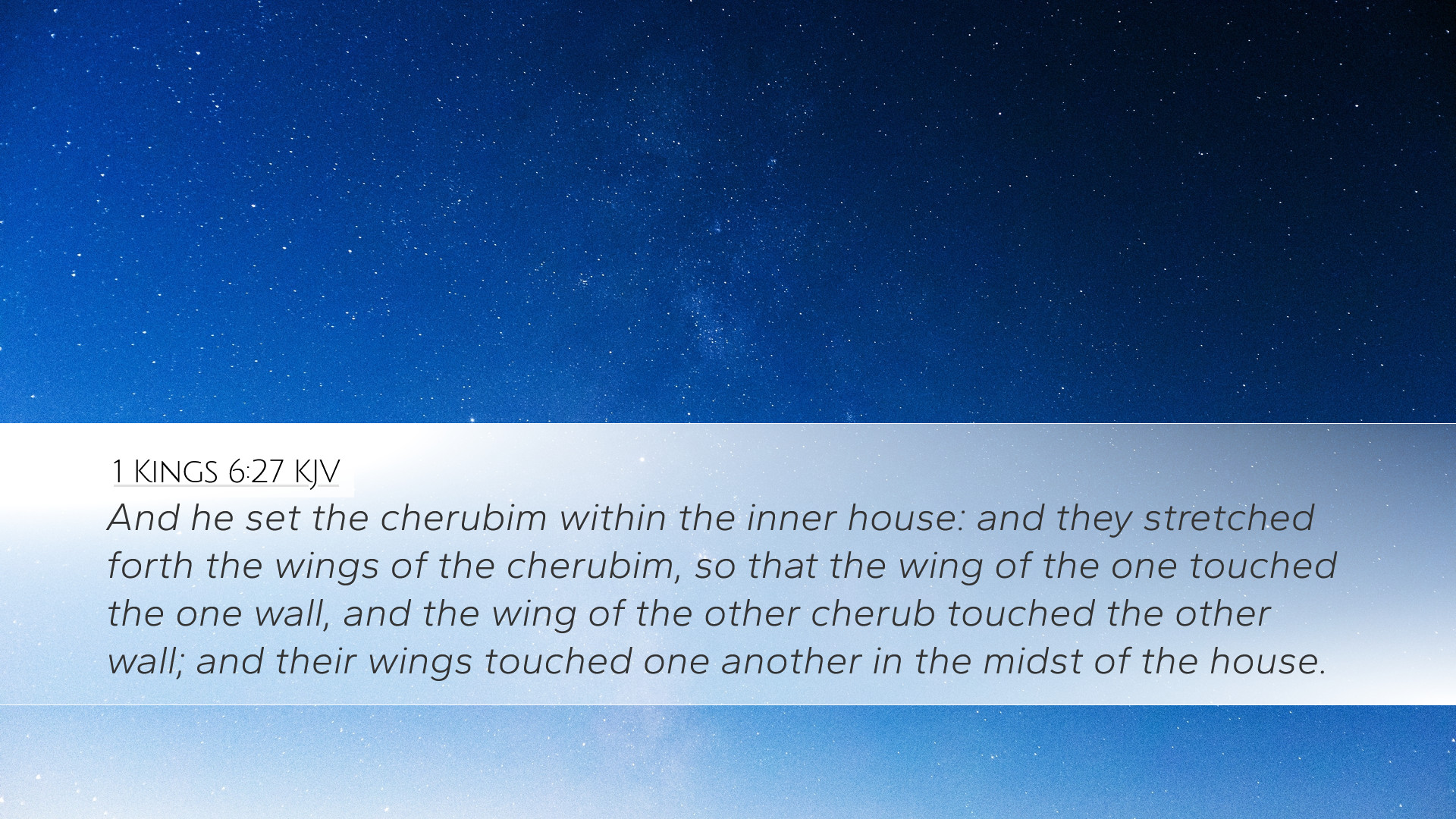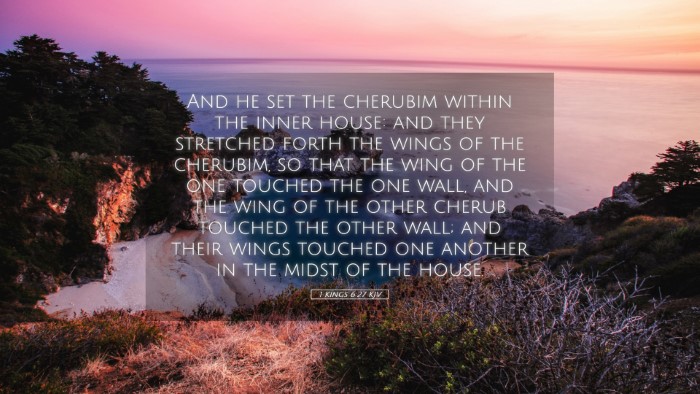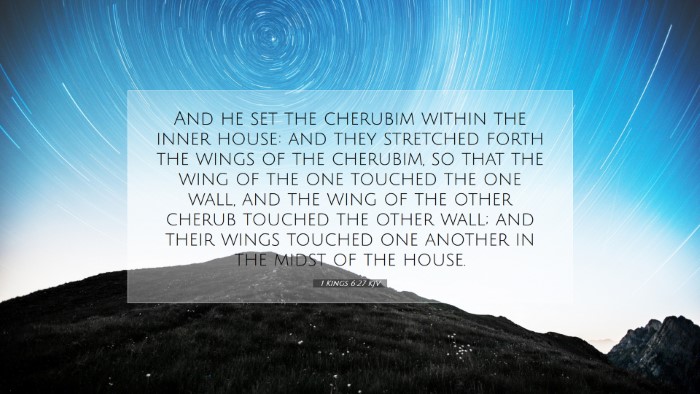Commentary on 1 Kings 6:27
Verse: "And he set the cherubims within the inner house: and they stretched forth the wings of the cherubims, so that the wing of the one touched the one wall, and the other cherub touched the other wall; and their wings touched one another in the midst of the house."
Introduction
This verse describes a significant aspect of Solomon's Temple, particularly the placement and arrangement of the cherubim in the inner sanctuary, the Holy of Holies. The imagery and symbolism embedded in this passage are rich and provide profound insights for pastors, theologians, and students alike. The significance of the cherubim and their function within the Temple is critical to understanding the nature of God's presence and the theological underpinnings of worship in ancient Israel.
Insights from Public Domain Commentaries
Matthew Henry's Commentary
Matthew Henry interprets the cherubim as vital symbols of God's glory and divine presence. This passage demonstrates God's promise to dwell among His people. Henry emphasizes that the spread of the cherubim’s wings signifies both protection and the majesty of God’s presence. The cherubim are described as guardians of holiness; their wings stretching towards each other embodies unity in divine purpose.
- Cherubim as Symbolic Figures: Henry notes that cherubim are often associated with God's throne, representing His sovereign power.
- Wings and Their Significance: The expansive wings convey God's protective nature over His people, creating a sacred space where heaven and earth meet.
- Unity of Purpose: The cherubim's wings touching each other indicates a harmony in the divine mission – to guard and to connect humanity with God.
Albert Barnes' Notes on the Whole Bible
Albert Barnes focuses on the architectural and spatial elements of the Temple's layout. He posits that the elaboration of the cherubim was not merely aesthetic but crucial to the Temple's function as a dwelling place for God. Barnes highlights several points:
- Physical Arrangement: The proximity of the cherubim's wings to the walls indicates that the inner sanctuary was designed with the intent to maximize the sense of God's proximity to His people.
- Dimensions and Scale: Barnes provides insights into the immense scale of these cherubim, emphasizing their overwhelming presence which serves to highlight God’s majesty.
- Theological Implications: The arrangement of the cherubim within the Temple is indicative of God’s desire for communion with humanity, setting the stage for worship and sacrifice.
Adam Clarke's Commentary
Adam Clarke approaches this passage with a focus on the spiritual implications of the cherubim and their role in the worship of Yahweh. He notes that the cherubim illustrate both God’s judgment and mercy. In his analysis, Clarke makes several observations:
- The Nature of Earthly Representatives: Clarke explains that the cherubim serve as earthly representations of heavenly beings, signifying that God's presence on earth reflects heavenly realities.
- Crossing Wings: The touching wings symbolize not only God's guardianship but also the linking of humanity with the divine, an important aspect of biblical theology.
- Worship and Reverence: Clarke asserts that the visual of the cherubim encourages worshippers to approach God with reverence, recognizing His holiness and their human frailty.
Theological Reflections
The imagery of the cherubim in 1 Kings 6:27 holds significant theological meanings. Their presence serves multiple functions:
- Divine Protection: The cherubim are seen as protectors of the holiness of God, establishing a boundary between the sacred and profane.
- Representation of God's Authority: They symbolize God's sovereign reign, reminding believers that He is seated above and in control of all creation.
- Invitation to Worship: The arrangement is an invitation to worship that evokes awe and reverence, encouraging worshippers to enter the presence of God with humility.
Application for Today
For contemporary pastors and church leaders, the principles derived from 1 Kings 6:27 can be applied in various ways:
- Encouraging Reverence in Worship: Churches today can draw from the understanding of cherubim as representatives of God's holiness to instill a sense of reverence in worship settings.
- Symbolic Use of Imagery: Utilizing symbolism in worship spaces can help congregants connect more deeply with the divine, emulating the theological significance seen in the cherubim.
- Teaching on Divine Presence: Pastors can teach about God's desire for relationship, emphasizing that in Christ, believers are invited into the fullness of His presence.
Conclusion
In conclusion, 1 Kings 6:27 is a profound passage rich in symbolism and theological insight. The cherubim serve as a reminder of God's holiness, His sovereign authority, and the invitation to engage in meaningful worship. Drawing from the insights of Matthew Henry, Albert Barnes, and Adam Clarke, we can see how this verse encapsulates core truths about God's relationship with His people and the importance of reverence and awe in worship. This understanding enables pastors, students, and scholars to appreciate the depth of scripture and apply its truths in the contemporary church context.


